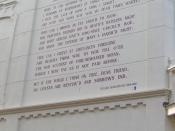William Shakespeare, in his Sonnet 73 and Sonnet 116, sets forth his vision of the unchanging, persistent and immovable nature of true love. According to Shakespeare, love is truly 'till death do us part,' and possibly beyond. Physical infirmity, the ravages of age, or even one's partner's inconstancy have no effect upon the affections of one who sincerely loves. His notion of love is not a romantic one in which an idealized vision of a lover is embraced. Instead he recognizes the weaknesses to which we, as humans, are subject, but still asserts that love conquers all.
Shakespeare uses an array of figurative language to convey his message, including metaphor and personification. Thus, in sonnet 73, he compares himself to a grove of trees in early winter, 'When yellow leaves, or none, or few, do hang Upon those boughs which shake against the cold,...' These lines seem to refer to an aged, balding man, bundled unsuccessfully against the weather.
Perhaps, in a larger sense, they refer to that time in our lives when our faculties are diminished and we can no longer easily withstand the normal blows of life. He regards his body as a temple- a 'Bare ruined choir[s]'- where sweet birds used to sing, but it is a body now going to ruin.
In Sonnet 116, love is seen as the North Star, the fixed point of guidance to ships lost upon the endless sea of the world. It is the point of reference and repose in this stormy, troubled world, 'an ever-fixed mark That looks on tempests and is never shaken;...'
He personifies the coming of the end of his life as night, which is described as 'Death's second self' in sonnet 73. However, in Sonnet 116 death appears in the guise of the grim...


